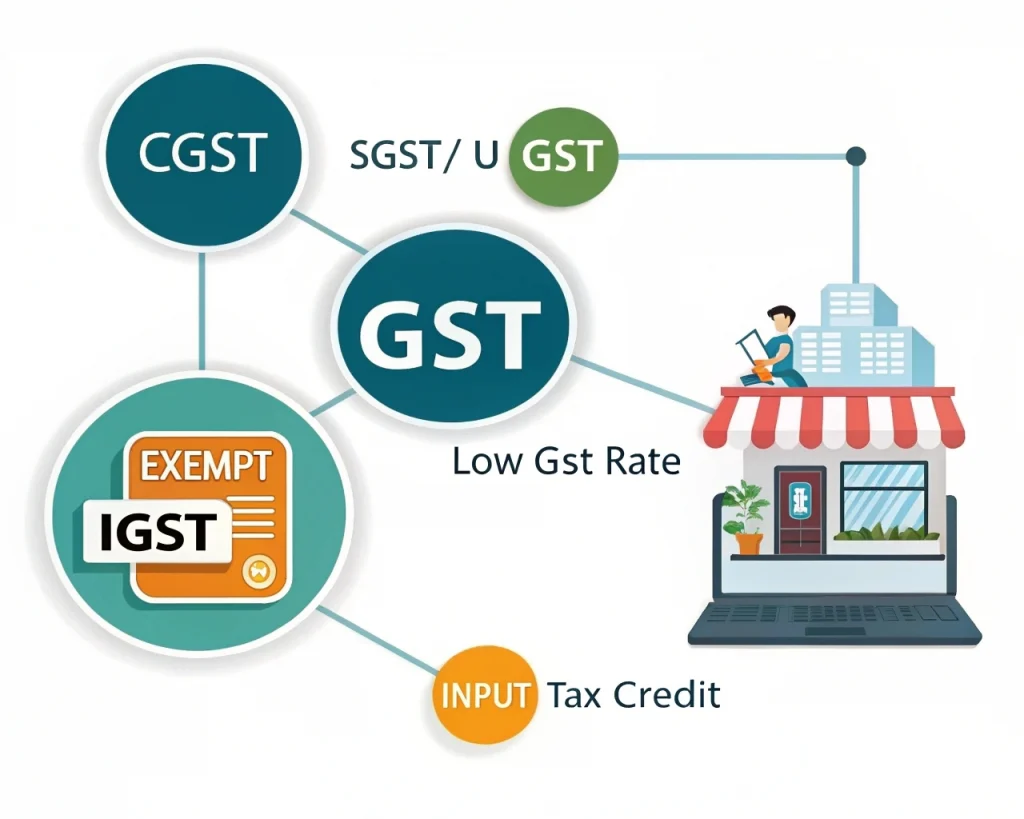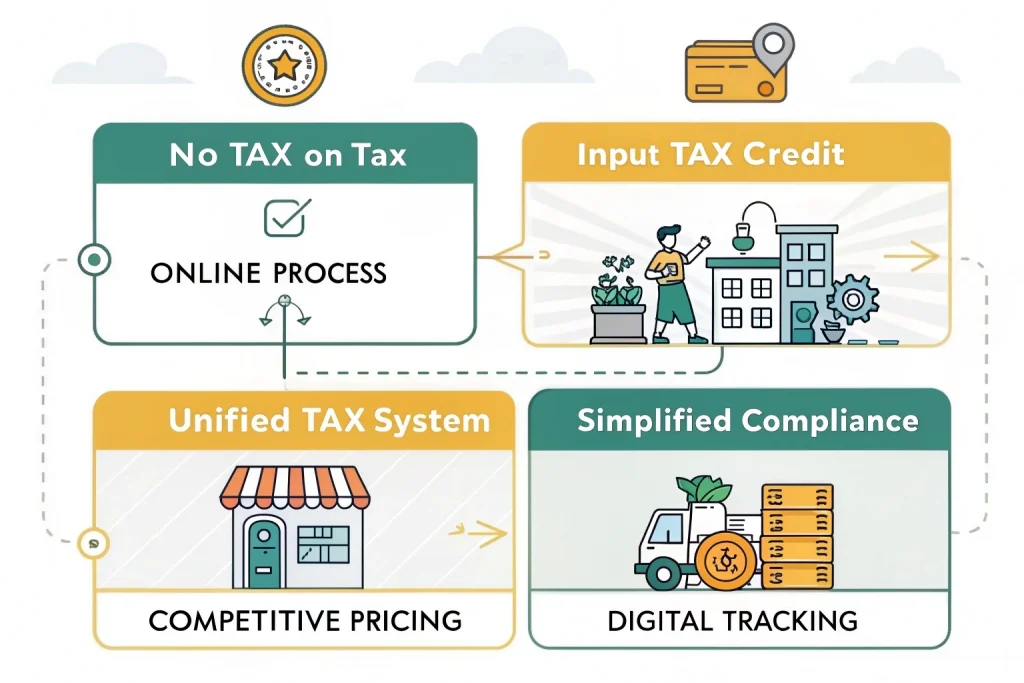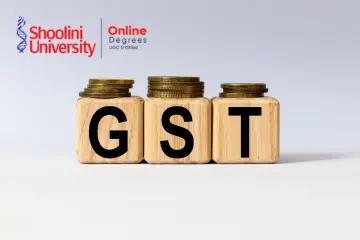With the idea of “one nation, one tax,” GST has changed the way indirect taxes work all over India in a big way. Main features of GST , such as unified tax rates, input tax credits, and easy online filing, have made it easier for businesses to follow the rules and more fair for customers.
At the same time, GST’s main goal is to get rid of the negative effects of having various taxes, lower prices, and make a single national market. This piece will talk about the most important parts of GST, including its main goals, when it will go into effect, and why it was such an important change for the Indian economy.
Features of GST

Indian taxes have been merged into a single system called GST, which everyone must follow. You now only have to pay one tax when you buy something instead of several. The place where you use or buy something gets the tax money. For example, if you order a toy online and have it sent to your house, the tax goes to your home state, not the store’s state.
If you live in a state, GST is split into two parts. SGST or UTGST goes to the state government, and CGST goes to the national government. You pay a special tax called IGST when you send goods from one state to another. This tax is then split fairly between the two states.
Businesses don’t have to pay tax on the same goods more than once because they can deduct the tax they paid on raw materials. This is called a “input tax credit.” Very small sellers whose annual sales are less than a certain amount don’t have to sign up for full GST. Instead, they can pay a low flat rate or not pay any GST at all. Last but not least, you can sign up, file your reports, and pay your taxes all online. This means you don’t have to fill out long forms or go to the tax office. This makes it easy for everyone to buy, sell, and run a business.
Objective of GST

The main goal of GST is to stop the “tax on tax” problem. Under the old system, you could end up paying tax every time a product changed hands. Now, businesses can subtract the tax they’ve already paid on materials or services (called input tax credit). This keeps costs down, so things don’t become more expensive just because they passed through many steps.
GST also replaces a tangle of different central and state taxes with one clear framework. Instead of juggling service tax, excise duty, VAT and more, everyone follows the same rules. This simpler structure makes it easier for small shopkeepers and big manufacturers alike to understand what they owe.
Because GST lowers extra tax costs, companies can sell their goods and services at better prices. This helps them compete both here in India and around the world. At the same time, a wider range of businesses now pay tax under GST, and most of it is tracked digitally. That means the government collects money more efficiently, with fewer leaks or unpaid bills.
Finally, transparent, online processes make life easier for everyone. Digital invoices show exactly how much tax was paid at each step, so it’s hard for anyone to hide or dodge payments. And from signing up to filing returns, the process is the same in every state—and it’s all done online, saving trips to the tax office and endless paperwork.
When Was GST Introduced in India?
India’s journey with GST started in late 2016, when the GST Council met for the first time on September 22, 2016. The finance ministers from both the national government and the state governments make up this council. Its job is to work out all the details and rules for the new tax system.
The law to change the Constitution and allow GST was presented in the Lok Sabha (India’s Parliament’s lower house) on July 19, 2016. It is known as the 101st Amendment. After talking about it and making some changes, the Lok Sabha decided on March 29, 2017, to pass it. The bill was then sent to the Rajya Sabha, which is the top house. On April 6, 2017, it was passed.
The last piece of approval came from the President on April 12, 2017. After finishing this last step, all that was left was to choose a date for implementation, which was July 1, 2017. GST became the law all over India on that day.
Explore our online programs to become future-ready
Transform your career with industry-aligned courses designed by experts.
When and From What Date Was GST Implemented in India?
Along with the rest of India, GST started for real on July 1, 2017. In that day, shops, factories, and internet sellers all switched from the old taxes they used to charge to GST.
At first, there were four major tax rates: 5% for everyday items, 12% to 18% for most goods and services, and 28% for “sin” or luxury items. This simple list of rates made it easy for everyone to get used to the new method.
Businesses had already paid their taxes under the old rules and had goods ready to sell before July 1. The government made sure those businesses wouldn’t lose out by letting them keep the tax credits they had won with the old taxes. It was a smooth switch, so no one had to pay more because the rules changed.
Need for GST
It was really hard to buy and sell things in India before GST. It was tax time for you. There was VAT, customs duty, and service tax to deal with. Shop and factory owners had to spend a lot of time filling out forms and finding out what they owed because each state had its own rules, forms, and rates.
Plus, tax was added to the product over and over again as it went from one step to the next, like from the factory to the wholesaler or from the wholesaler to the shop. In other words, people paid “tax on tax,” which made things cost more. Also, trucks had to stop at a lot of checkpoints when going from one state to another, which slowed down supplies and cost more.
These issues were solved by GST, which merged all of these into a single system. A business owner can save time and money by only having to learn about one tax and one set of online forms. Since there are not as many stops, things move faster as well.
The most important thing about GST is that it turned India into one big market. The rules are the same in Chennai as they are in Chandigarh. For buyers, this means getting fair prices no matter where they live and for sellers, it helps them reach more people.
How Many Types of GST Are There in India?
Indian GST is made up of four key parts that help decide where and how the tax money is spent:
A two-part tax is charged when you buy or sell something in the same state. The central government gets a part of it, which is called CGST (Central GST). SGST (State GST) or UTGST (for Union Territories) is the other part that goes to the state or region where the sale takes place.
IGST is the tax you pay when you buy something in one state and use it in another. With this one tax, it’s easy for the two states to split the money evenly.
Last but not least, there is a small extra fee called Compensation Cess. This only goes for high-end items (like expensive cars) or things the government wants to spread less of (like tobacco goods). The extra cash helps states make up for any lost tax money while they get used to the new GST system.
Conclusion
GST got rid of a lot of complicated taxes all at once and replaced them with a single, simple system. When you buy or use something, you only pay tax once. Businesses can get back the tax they’ve already paid. India has the same rules, and everything is done online, so there is no “tax on tax” and no need to wait. GST makes it easier, better, and more efficient for all of us to trade by putting everyone in one place.


Leave a Reply